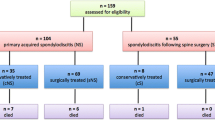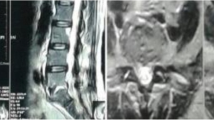Abstract
Introduction
The aim of this study was to review the patients with lumbar epidural abscess in terms of neurological morbidity, therapeutic outcome, and prognosis, while assessing the usefulness of a new MRI staging classification and specific imaging findings as indicators for surgical management.
Materials and methods
We reviewed 37 patients who sustained epidural abscess associated with pyogenic spondylodiscitis of the lumbar spine. Ten patients were treated conservatively, while 27 required urgent or elective surgical drainage. We studied patients with respect to symptomatology, Frankel-American Spinal Injury Association (ASIA) scale evaluation and a new proposed system of MRI staging of pyogenic spondylodiscitis (stages I–V).
Results
Of the 37 patients with stage IV and V MRI lesions, 13 (35%) had septicemia and 8 (22%) presented with Frankel-ASIA scale C-D neurological status. All cases with ringlike enhancement on gadolinium-enhanced MRI in the epidural abscess lesions were treated surgically. Progression of local kyphosis and loss of intervertebral disk height were significantly prevented in the surgical group (P < 0.05). Improvements of neurological status and laboratory data were better in the surgical group than the conservative group (P < 0.05), with significantly short hospital stay (P < 0.05).
Discussion
Epidural abscess associated with pyogenic spondylodiscitis presents with various neurological symptoms. In addition to assessment of progression by clinical symptomatology, modified neurological Frankel-ASIA scaling and the currently proposed MRI staging regimen may help to consider the timing of surgical intervention. In the acute, subacute or acute-on-chronic phase and the ringlike enhancement pattern of epidural abscess on gadolinium-enhanced MRI may be an indicator for surgery.


Similar content being viewed by others
References
Akalan N, Ozgen T (2000) Infection as a cause of spinal cord compression: a review of 36 spinal epidural abscess cases. Acta Neurochir (Wien) 142:17–23
American Spinal Cord Association (2002) International standards for neurological classification of spinal cord injury. American Spinal Injury Association, Chicago
Baba H, Maezawa Y, Kokubo Y, Kawahara N (1995) Rapidly progressing quadriparaesis secondary to cervical pyogenic spondylitis in a patient with Klippel-Feil syndrome. J Spinal Disord 8:151–156
Baba H, Uchida K, Wada M, Imura S, Kawahara N, Tomita K (1997) Vertebral lesions associated with palmoplantar pustulosis. Int Orthop 21:19–24
Eismont FJ, Bohlman HH, Soni PL, Goldberg VM, Freehafer AA (1983) Pyogenic and fungal vertebral osteomyelits with paralysis. J Bone Joint Surg Am 65A:19–29
Feldenzer JA, McKeever PE, Schaberg DR, Campbell JA, Hoff JT (1987) Experimental spinal epidural abscess. A Pathophysiological model in the rabbit. Neurosurgery 20:859–867
Feldenzer JA, McKeever PE, Schaberg DR, Campbell JA, Hoff JT (1988) The pathogenesis of spinal epidural abscess: microangiographic studies in an experimental model. J Neurosurg 69:110–114
Hanigan WC, Asner NG, Elwood PW (1990) Magnetic resonance imaging and the nonoperative treatment of spinal epidural abscess. Surg Neurol 34:408–413
Hadjipavlou AG, Katonis PK, Gaitanis IN et al (2004) Percutaneous transpedicular discectomy and drainage in pyogenic spondylodiscitis. Eur Spine J 13:707–713
Hanaoka N, Kawasaki Y, Sakai T et al (2006) Percutaneous drainage and continuous irrigation in patients with severe pyogenic spondylitis, abscess formation, and marked bone destruction. J Neurosurg Spine 4:374–379
Heyde CE, Boehm H, Saghir H, Tschöke SK, Kayser R (2006) Surgical treatment of spondylodiscitis in the cervical spine: a minimum 2-year follow-up. Eur Spine J 15:1380–1387
Hlavin ML, Kaminski HJ, Roos JS, Ganz E (1990) Spinal epidural abscess. A 10-year perspective. Neurosurgery 27:177–184
Kälicke T, Schmitz A, Risse JH et al (2000) Fluorine-18 fluorodeoxyglucose PET in infectious bone diseases: results of histologically confirmed cases. Eur J Nucl Med 27:524–528
Khanna RK, Malik GM, Rock JP, Rosenblum ML (1996) Spinal epidural abscess: evaluation factors influencing outcome. Neurosurgery 39:958–964
Kapeller P, Fazekas F, Krametter D et al (1997) Pyogenic infectious spondylitis: clinical, laboratory and MRI features. Eur Neurol 38:94–98
Klein M, Ahn CS, Drum DE, Tow DE (1994) Gallium-67 scintigraphy as an aid in detection of spinal epidural abscess. Clin Nucl Med 19:761–762
Kobayashi S, Baba H, Takeno K et al (2008) Fine structure of cartilage canal and vascular buds in the rabbit vertebral endplate. J Neurosurg Spine 9:96–103
Kobayashi S, Negoro K, Uchida K et al (2007) Successful treatment of nonclostridial gas gangrene extending from retroperitoneum to thigh associated with occult cecal cancer. J Orthop Sci 12:585–591
Kulowski J (1936) Pyogenic osteomyelitis of the spine. An analysis and discussion of 102 cases. J Bone Joint Surg 18:343–364
Mampalam TJ, Rosegay H, Andrews BT, Rosenblum ML, Pitts LH (1989) Nonoperative treatment of spinal epidural infections. J Neurosurg 71:208–210
Naktin J, De Simone J (1999) Lumbar vertebral osteomyelitis with mycotic abdominal aortic aneurysm caused by highly penicillin-resistant Streptococcus pneumoniae. J Clin Microbiol 37:4198–4200
Numaguchi Y, Rigamondi D, Rothman MI, Sato S, Mihara F, Sadato N (1993) Spinal epidural abscess: evaluation with gadolinium-enhanced MR imaging. Radiographics 13:545–559
O’Daly BJ, Morris SF, O’Rourke SK (2008) Long-term functional outcome in pyogenic spinal infection. Spine 33:E246–E253
Ogden AT, Kaiser MG (2004) Single-stage debridement and instrumentation for pyogenic spinal infections. Neurosurg Focus 17:E5
Quiñones-Hinojosa A, Jun P, Jacobs R, Rosenberg WS, Weinstein PR (2004) General principles in the medical and surgical management of spinal infections: a multidisciplinary approach. Neurosurg Focus 17:E1
Rand N, Ashkenazi E (1999) Spinal epidural abscess. In: Gloman Y (ed) Spinal infections; spine; state of the art reviews. Hanley & Belfus, Philadelphia, pp 123–136
Rath SA, Neff U, Schneider O, Richter HP (1996) Neurosurgical management of thoracic and lumbar vertebral osteomyelitis and discitis in adults: a review of 43 consecutive surgically treated patients. Neurosurgery 38:926–933
Schwartz AJ (1999) Imaging of spinal infections. In: Gloman Y (ed) Spinal infections; spine; state of the art reviews. Hanley & Belfus, Philadelphia, pp 21–35
Siddiq F, Chowfin A, Tight R, Sahmoun AE, Smego RA Jr (2004) Medical vs surgical management of spinal epidural abscess. Arch Intern Med 164:2409–2412
Delinger RP, Carlet JM, Masur H et al (2004) Surviving sepsis campaign guidelines for management of severe sepsis and septic shock. Crit Care Med 32:858–871
Uchida K, Kobayashi S, Sato R et al (2008) Anterior spinal artery syndrome complicating massive paravertebral abscess. J Orthop Sci 13:85–88
Uchida K, Kobayashi S, Yayama T et al (2004) Metabolic neuroimaging of the cervical spinal cord in patients with compressive myelopathy: a high-resolution positron emission tomography study. J Neurosurg Spine 1:72–79
Veillard E, Guggenbuhl P, Morcet N et al (2000) Prompt regression of paravertebral and epidural abscesses in patients with pyogenic discitis. Sixteen cases evaluated using magnetic resonance imaging. Joint Bone Spine 67:219–227
Woertgen C, Rothoerl RD, Englert C, Neumann C (2006) Pyogenic spinal infections and outcome according to the 36-item short form health survey. J Neurosurg Spine 4:441–446
Yayama T, Uchida K, Kokubo Y, Baba H (2003) Lumbar epidural abscess causing septic shock: case report. J Orthop Sci 8:109–111
Author information
Authors and Affiliations
Corresponding author
Rights and permissions
About this article
Cite this article
Uchida, K., Nakajima, H., Yayama, T. et al. Epidural abscess associated with pyogenic spondylodiscitis of the lumbar spine; evaluation of a new MRI staging classification and imaging findings as indicators of surgical management: a retrospective study of 37 patients. Arch Orthop Trauma Surg 130, 111–118 (2010). https://doi.org/10.1007/s00402-009-0928-3
Received:
Published:
Issue Date:
DOI: https://doi.org/10.1007/s00402-009-0928-3




